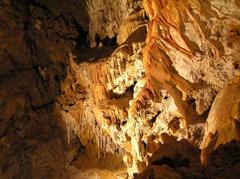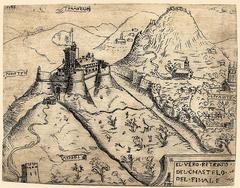Arene Candide Visiting Hours, Tickets, and Comprehensive Guide to Finale Ligure Historical Sites
Date: 14/06/2025
Introduction
Nestled atop the Caprazoppa promontory with breathtaking views over the Ligurian Sea, the Arene Candide Cave in Finale Ligure, Italy, is a window into more than 30,000 years of human history. As one of the best-preserved and most thoroughly researched archaeological sites in the Western Mediterranean, the cave is celebrated for its rich stratigraphy, extraordinary artifacts, and the renowned “Young Prince” burial. These discoveries collectively offer invaluable insights into ancient funerary customs, social structures, and the transition from hunter-gatherer groups to the first agricultural societies.
A visit to Arene Candide is both educational and immersive. Guided tours, led by professional archaeologists, reveal the cave’s complex history, while the nearby Museo Archeologico del Finale showcases many of its greatest treasures. The surrounding region offers medieval villages, scenic hiking trails, and outstanding local cuisine, making Finale Ligure a well-rounded destination for travelers seeking both cultural enrichment and natural beauty.
This guide provides up-to-date details on Arene Candide visiting hours, ticketing, accessibility, and practical travel tips, as well as recommendations for exploring the best historical sites in Finale Ligure. For the latest updates, check resources such as the official museum website and local tourism portals (mudifinale.com; museoarcheologicodelfinale.it; audiala.com).
Archaeological Layers and Chronology
The Arene Candide Cave boasts stratified layers reaching nearly 10 meters deep, spanning from the Upper Paleolithic (ca. 34,000 BCE) through to the Byzantine period (6th–7th century CE) (preistoriainitalia.it). This uninterrupted archaeological record makes it a touchstone for Mediterranean prehistory.
Upper Paleolithic (ca. 34,000–10,000 BCE)
Human occupation at Arene Candide began around 34,400 years ago. During this period, the cave served as a shelter and burial site for hunter-gatherer groups. The most significant discovery is the “Young Prince” burial: a 15-year-old male, interred with mammoth ivory pendants, a long flint dagger, a cap decorated with shells, and four pierced elk antlers, interpreted as “staffs of command” (mudifinale.com; showcaves.com).
An Epigravettian necropolis with at least 20 burials dated between 12,000 and 10,000 years ago has also been uncovered, offering critical information on mortuary practices and social organization among Upper Paleolithic groups (wikipedia; sciencedirect.com).
Mesolithic and Neolithic (ca. 10,000–3,600 BCE)
In the Mesolithic and especially during the Neolithic, the cave was used as a settlement, animal shelter, and burial site. The oldest evidence for the Neolithic in northern Italy comes from here, including a barley grain embedded in pottery dated to around 5,800 BCE, marking the onset of agriculture in the region. Neolithic burials are characterized by cist tombs, where individuals were interred in a fetal position (preistoriainitalia.it).
Metal Ages, Roman, and Byzantine Periods
The cave continued to be used through the Copper, Bronze, and Iron Ages, with evidence of occupation and changing activities. In the Roman and Byzantine periods, the cave was repurposed for storage and production, as suggested by ceramics and other artifacts (mudifinale.com).
Key Archaeological Discoveries
- The “Young Prince” Burial: Excavated in the 1940s, this Upper Paleolithic grave stands as one of the most significant in European prehistory due to its elaborate grave goods and exceptional preservation (mudifinale.com).
- Paleolithic Necropolis: The site contains a unique cluster of at least 19–20 Paleolithic burials, allowing for detailed studies of ancient health, diet, and lifeways (wikipedia; sciencedirect.com).
- Neolithic and Later Burials: Numerous cist tombs and funerary artifacts from the Square Mouthed Vases culture demonstrate the development of complex burial rituals (mudifinale.com).
- Artifacts and Material Culture: The cave has yielded flint tools, early ceramics, ornamental items, and Roman/Byzantine ceramics (preistoriainitalia.it).
Visiting Arene Candide Cave
Visiting Hours and Tickets
- Open: April–October, Tuesday to Sunday, 9:30 AM–5:00 PM; closed Mondays and public holidays.
- Entry: By guided tour only. Prices as of 2025: €12 for adults, €8 for seniors and students, children under 12 free.
- Booking: Advance reservation required due to limited group sizes. Book online via the Museo Archeologico del Finale or by phone at +39 019-690020.
Accessibility
While museum facilities are accessible, the cave itself has uneven terrain and may be challenging for those with mobility impairments. Contact the museum ahead of your visit for assistance.
Guided Tours
Tours are led by experienced archaeologists, offering in-depth explanations of the cave’s structure, major discoveries, and archaeological significance. Tours are available in Italian and English, and group sizes are kept small to protect the site.
Travel Tips
- Wear sturdy shoes and bring a jacket; the cave remains cool year-round.
- Facilities such as restrooms and cafés are available in Finale Ligure and Finalborgo.
- Plan to combine your visit with the museum and nearby historic sites for a full experience.
Display and Interpretation of Artifacts
Key finds from Arene Candide, including the “Young Prince” burial, are displayed at:
Both museums feature multimedia exhibits and reconstructions for a comprehensive understanding of the site.
Preservation and Visitor Guidelines
- Access is strictly by guided tour; group sizes are limited for preservation.
- Do not touch cave walls, formations, or artifacts.
- Flash photography is prohibited.
- Environmental monitoring ensures conservation of the cave’s delicate conditions.
Integration with Finale Ligure’s Historical Sites
Finalborgo
A medieval gem, Finalborgo is listed among “The Most Beautiful Villages in Italy.” Its ancient walls, pastel buildings, artisan shops, and vibrant cafés offer a charming contrast to the prehistoric cave.
Castel Gavone & Forte San Giovanni
Castel Gavone, a 12th-century fortress, and Forte San Giovanni, a 17th-century fortification, both perched above Finalborgo, provide panoramic views and engaging historical tours.
Religious & Artistic Landmarks
Visit the Collegiata di San Biagio and Abbazia dei Padri Benedettini for striking Baroque and Romanesque architecture.
Natural Attractions
The Caprazoppa promontory is ideal for hiking and nature photography, while Finale Ligure’s beaches invite swimming and relaxation.
Outdoor & Adventure Activities
Finale Ligure is also renowned for rock climbing, mountain biking, and scenic walking trails.
Practical Travel Tips
- Book Tours Early: Especially in high season.
- Dress Appropriately: For cave conditions and outdoor activities.
- Transportation: Finale Ligure is accessible by train and local buses; most attractions are within walking or biking distance.
- Respect Guidelines: Help preserve the site for future generations.
Frequently Asked Questions (FAQ)
Q: What are the cave’s visiting hours?
A: April–October, Tuesday–Sunday, 9:30 AM–5:00 PM. Always confirm on the official website.
Q: How do I book tickets?
A: Online via the Museo Archeologico del Finale or by calling +39 019-690020.
Q: Is the cave accessible for people with disabilities?
A: The museum is accessible, but the cave’s terrain may pose challenges. Contact staff in advance for advice.
Q: Are guided tours available in English?
A: Yes, tours are offered in both Italian and English.
Q: Where are the cave’s artifacts displayed?
A: At the Museo Archeologico del Finale and the Civic Museum of Ligurian Archaeology.
Enhance Your Visit
Explore Finale Ligure’s medieval streets, sample Ligurian cuisine, and attend local festivals for a well-rounded journey. For maps, virtual tours, and images, visit Visit Finale Ligure and download the Audiala app for audio guides and up-to-date information.
Conclusion
The Arene Candide Cave is a landmark of prehistoric and Mediterranean history, offering visitors a unique chance to walk in the footsteps of ancient peoples. Combined with Finale Ligure’s medieval charm, dramatic landscapes, and vibrant local culture, it promises a memorable and enriching experience.
Plan your visit by confirming hours and tickets, booking guided tours, and exploring complementary attractions. Stay connected with local resources and the Audiala app for the latest updates and travel inspiration.
Sources and Further Reading
- Arene Candide Cave: Visiting Hours, Tickets, and History of Finale Ligure’s Iconic Archaeological Site, Mudifinale
- Arene Candide Cave Visiting Hours, Tickets & Exploring Historical Sites in Finale Ligure, Archaeological Museum of Finale
- Grotta delle Arene Candide Visiting Hours, Tickets, and Historical Guide to Finale Ligure’s Prehistoric Cave, Audiala
- Exploring Arene Candide and Complementary Attractions in Finale Ligure: Visiting Hours, Tickets, and Historical Sites, Mudifinale
Visual recommendations: Feature images of the cave entrance, the “Young Prince” burial artifacts, panoramic Ligurian coast views, and Finalborgo village, with alt text like “Arene Candide Cave entrance” and “Young Prince burial artifacts at Finale Ligure museum.”
Internal links suggestion: Guide readers to related articles on Ligurian cuisine, hiking trails, and local festivals for deeper exploration.

